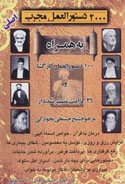What is the difference between Suna and Sheea?
What is the difference between Suna and Sheea?
Shia and Sunni are terms for the two largest groups of Muslims. The points of convergence between these groups are a lot more than what they differ in, what is important here is that the points of differences cannot be understood without returning to the reason or the Islamic thought that the Shiite school is based on in comparison to the other schools.
The Great Martyr Al Sadr explains in his book ''The Emergence of Shiism and the Shiites'' speaking about the genesis of the two main currents during the Prophets (s.a.w) lifetime:
''The two chief tendencies closely associated, from the start, with the emergence of the Islamic Ummah during the Prophets lifetime are:
One: The current representing a belief in the devotional acts of religion, it's arbitral power and the unconditional acceptance of religious stipulations for every aspect of life. (This is the tendency of the school of those who upheld the rights of the Prophetic Household and Shiism.)
Two: The current, which sees religious faith as eliciting devotional deeds within the special scope of overt acts of worship only. It believes in the possibility of independent legal judgment (ijtihad) and free discretion for the amendment and improvement of religious stipulations according to benefits (masalih), which might accrue in other domains of life (This is the tendency of the Sunni Schools.)
These two currents were both reflected and manifested when the Prophetic tradition granting the leadership to Ali Ibn abi Talib was confronted, one strived in opposition to the tradition while the other stood with the tradition.
From then the school of obeying the tradition by following Ali was born. He then goes on to explain: ''The two currents, whose rivalry began in earnest during the Prophets (s.a.w) own lifetime, were reflected in the Muslims position regarding the thesis of the Imams' pre-eminence in the mission after the Prophet (s.a.w).
Those representing the devotional tendency (as opposed to the one for independent legal judgment) found in the Prophets (s.a.w) stipulation the reason for accepting the doctrine without hesitation or adjustment.
The advocacy of independent legal judgement was viewed as offering the possibility of reason from the pattern established by the Prophet (saw) whenever judgement imagined to be more harmonious with the circumstances was called for. By the same token one observes that Shiites arose immediately after the Prophet's (s.a.w) death, representing the Muslims who adhered in practice to the doctrine of the Imams'
pre-eminence and leadership, the first steps of whose implementation the Prophet (s.a.w) had declared obligatory right after his departure. The Shiite current embodied from the first a repudiation of the Saqifah Council's attempt to paralyse the doctrine for Imam Ali's pre-eminence and to transfer authority to someone else.
("The emergence of Shiism and the Shiites." by Shaheed Al-Sadr.)
Shaheed Al-Sadr believes that the Muslims did not follow the leadership of Imam Ali and the reason for this goes back to their way of thinking.
On these bases the Shiite viewed the position of Imamate from a special perspective emerging from the importance of leadership and that the Imam is the true caliph of the Prophet (s.a.w) on earth.
Therefore the Imam had to be of impeccable character & outstanding qualities enabling him to occupy the position of leadership.
Like infallibility, endowed knowledge and complete understanding of the existence man and the divine law. Thus the Imam (as) is a reflection of the Prophet (s.a.w) in all his qualities except the connection with revelation.
"You are to me in status as Haroon (as) was to Musa (as) except that there is no Prophet after me." (Prophetic tradition)
This is the basic difference between Shiite and Sunni, that the Shiite understand the position of leadership to be absolute and not relevant, that it could be through the allegiance of the Ummah or its consensus on a specific person as is the view of Scholars of the Ahle-Sunnat.
Therefore we find that the primary and secondary aspects, which both schools have practiced according to the dictates of the Prophet (saw) like prayer, fasting, pilgrimage, other acts of worship and transactions in their general forms have not been subject to differences.
Differences however occurred in certain analytical deductions thus on one hand for example the Shiite differ with the Hanabila but concur with the Shawafi in a specific issue. Similarly the Shawafi will concur with Hanabila based on proof, likewise with the other schools (Maliki and Hanafi). We find on the other hand they (the Shiite) concur and do not differ with the other Sunni Schools in most issues. For further information on this topic you may refer to ("Figh according to the Five Schools") Sheikh Jawad Mughniyya.
The same applies to the theological aspects, we find that the general principles that makes a person a Muslim or a Kaafir viz. Unity of Allah, Prophet-hood and Resurrection are agreed upon, but difference in Imamate which the Shiite consider to be of the fundamentals whereas the Sunni's don't.
On the issue of Justice we do not find the difference based on Sunni or Shiite but rather it is between the School of Adliyat (proponents for) and the School of Asha'irat (those against).
The Mu'tazila for example are part of the Sunni School but are proponents for the concept of Divine Justice. The issue of Justice is dealt with in theological discourses.
Like the issue of Good and Evil being of the intellect or not.
Similarly you find that the Shiite concur with the Asha'ira in some theological issues and differ with the Mu'tazila, thus the issue was not viewed on the basis of
Jurisprudence but studied according to intellectual and legal means.
مطالب مشابه با این موضوع:
وبگــــــــــردی طلبۀ پاسخگو
- فایل اعمال و رفتار های خلاف قانون جناب آقای حسن روحانی
- در کنج خانه طلبهها چه میگذرد؟
- سکوت چند ساله مسئولان حوزه در قبال حملات وحشیانه به طلاب!
- می گویند که مملکت مملکت آخوندهاست!!
- یک ماجرای تلخ که خانم ها با تأمل بیشتر بخونند
- جریان های تکفیری موجود در عراق و نحوه شکل گیری آنها
- سیر تکاملی تفکر سلفیه چگونه بوده است؟
- بداء در قرآن و حدیث چگونه مطرح شده است؟
- پیامبر (ص) با مخالفین خود چگونه بر خورد می کرد؟
- سبک زندگی حضرت زهرا سلام الله علیها
- ملاک کرامت و شرافت افراد، انسانیت است یا جنسیت؟
- رنگ و پوشش های رنگی در اسلام
- حجاب، زنان را افسرده میکند و مانع پیشرفت اجتماعی آنهاست!!!
- علوم لدنی معصومین
- مگر ولی فقیه معصوم است که ولایت مطلقه دارد؟
- اگر خدا ازعاقبت ما اطلاع دارد قیامت برای چیست؟
- آیا بجای نماز خوندن، پیانو یا سه تار بزنم؟
- چرا مراسم عزاداري امام حسين(ع) پيش از شهادت ايشان صورت ميگيرد؟
- چرا امام حسين(ع) در كربلا براي رفع تشنگي از خداوند طلب باران نكرد؟
دانــــــلود های مفیـــــــــــــــــــد
- دانلود پاورپوینت شناخت وهابیت و صهیونیسم و ارتباط با همدیگر
- دانلود دو پاورپوینت اجرای عید غدیر خم
- دانلود پاورپوینت احتجاج اميرمؤمنان (ع) به غدير
- پژوهشی در کلام و پیام مقام معظم رهبری پیرامون ماه رمضان
- خطبه شعبانیه و خطبه امیرالمومنین(علیه السلام) پیرامون روزه و ماه رمضان
- دانلود پاورپوینت و pdf تفاوت های زن و مرد
- دانلود جزوه ساعات سعد و نحس(زمان نوشتن دعا)
- تقویم مذهبی شمیم یار 96 مخصوص کامپیوتر
- دانلود نرم افزار «شیعه شناسی»
- دانلود پاورپوینت ساختار خانواده و مسایل آن
- دانلود کتاب دایره المعارف جنسی
- دانلود نکات جذاب دوران عقد
- دانلود کتاب درمان سرد مزاجی و بی میلی جنسی بانوان
- دانلود کتاب حسادت کودکان
- دانلود کتاب درمان خستگی وناتوانی جنسی
- دانلود پاور پوینت اسیب های ازدواج وخانواده
- دانلود پاورپوینت هشت گام برای تحقق رویا به واقعیت
- دانلود پاورپوینت تقویت اراده
- دانلود پاورپوینت موفقیت وروشهای رسیدن به ان
- دانلود پاورپوینت هنر رفتار با افراد دشوار
- دانلود پاورپوینت جملات جالب وجذاب روحیه بخش بزرگان
- دانلود پاورپوینت راههای مقابله ودرمان استرس
- دانلود پاورپوینت نیازهای اساسی کودکان
منبــــرهای مکــــــــــــــــــتوب
- منبر مکتوب: روز عرفه و فرصت ها
- منبر مکتوب: سبک زندگی امام باقر علیه السلام
- منبر مکتوب: سه نیاز مومن (امام جواد علیه السلام)
- سخنرانی سلسله ای و چند جلسه ای مناسبت ماه رمضان
- دانلود 30 جلسه سخنرانی ماه مبارک با موضوع تنها مسیر
- موضوعات پیشنهادی سخنرانی برای محرم
- فضائل حضرت قمر بنی هاشم علیه السلام
- برکات وجود ابا عبدالله علیه السلام بر عالم
- بررسی بُعد اخلاقی،عبادی و عرفانی عاشورا
- آخرين وصيت امام حسين عليه السلام
- اولین علت رویاروی در کربلا؛ دوری از یاد خدا
- هميشه حزن؟ شادي چرا نه؟ - شب دهم محرم
- چرا نفرين ؟ - شب نهم محرم
- نماز ظهر عاشورا - شب هشتم محرم
- فلسفه عزاداری - شب هفتم محرم
- دفاع از دین - شب ششم محرم
- فلسفه حضور خانواده سيد الشهداء - شب پنجم محرم
- علم امام علیه السلام به شهادت - شب چهارم محرم
- فقدان شرایط امر به معروف و نهی از منکر- شب سوم محرم
مناظرات طلبه پاسخگو
جدیدترین های زبان انگلیسی
- Islam and Its Social System
- Duties of Man Towards the People
- Islam Various Systems
- Attributes of The Real Follower of Imams in Their Teachings
- Who is a Real Shia Muslim?
- RIGHTS OF SCHOLARS
- Islam Attacks Slavery 1
- The Advantages of Religion 2
- The Clearest Reason for Free Will
- Sheikh Zakzaky to be released on bail
- Brief History of Religions
- Is It Necessary For Man To Follow A Religion?
- The Advantages of Religion 1
- Who Is Almighty Allah?
- What are the differences between Shia and Sunni Muslims؟
- The Rights Islam Offers to Women
- How I find that Islam does not Oppress Women?
- URGENT MEDICAL TREATMENT FOR SHEIKH ZAKZAKY
- The motto of this year’s book fair is “Reading Is Ability”.
- Fundamental principles of Islam
بیشترین دانلود ها
- دانلود صوتي تکنیک های نزدیکی زن و شوهر (107631)
- دانلود رایگان کتاب خواص سوره های قرآن (53675)
- دانلود پاورپوینت بسیار مفید مهارت های زندگی (36552)
- دانلود كتاب مسائل جنسي و زناشوئي در احاديث (32991)
- دانلود پاورپوینت و pdf تفاوت های زن و مرد (32359)
- دانلود کتاب دایره المعارف جنسی (30430)
- دانلود پاورپوینت های آموزش پیش از ازدواج (29648)
- دانلود بسیار مفید پاورپوینت آئین همسرداری (28934)
- دانلود پاورپوینت آموزشی بررسی رابطه دختر و پسر (28616)
- دانلود 110جلد کتاب بحارالانوار علامه مجلسی ره (28409)
- دانلود كتاب دختران خوب به آسمان می روند دختران بد به همه جا (27509)
- دانلود کتاب آموزش جنسی آقایان (27434)
- دانلود كتاب فرق و مذاهب كلامي استاد رباني گلپايگاني (27391)
- دانلود کتاب درمان سرد مزاجی و بی میلی جنسی بانوان (26676)
- دانلود نکات جذاب دوران عقد (26115)
- دانلود نرم افزار «شیعه شناسی» (24447)
- دانلود کتاب درمان خستگی وناتوانی جنسی (23779)
- دانلود پاورپوینت روزه و روزه داری (22494)
جدیدترین مطالب سایت
- پاسخ به شبهات ولایت (4288) بازدید
- پاسخ به شبهات ولایت (4088) بازدید
- اذان در جامعه اسلامی نماد چیست ؟ و چرا فقط سه بار در روز تکرار می شود ؟ (3657) بازدید
- باتوجه به عادل بودن خداوند چرا بعضی از انسانها را ناقص الخلقه آفریده است ؟ (3731) بازدید
- ویژگی خاص قرآن چیست که کسی نمی تواند مانند آن را بیاورد ؟ (3802) بازدید
- با توجه به ترک خود ارضایی عوارض آن هنوز در من هست چگونه آن را برطرف کنم ؟ (5293) بازدید
- آیا بدن اخروی مانند بدن مادی است ؟چهره ی واقعی انسان در قیامت چگونه است ؟ (4604) بازدید
- آیا ادعای ملاقات امام زمان (عج) از جانب برخی افراد صحت دارد ؟ (4090) بازدید
- چرا به اصول و قواعد دین اسلام توجه نمی شود و پذیرش آن از سوی پیروان ادیان دیگر سخت است ؟ (4420) بازدید
- فلسفه وجود لباس روحانیت در عصر حاضر چیست ؟ (3351) بازدید
- آیا وظیفه یک روحانی تنها راهنمایی مردم و فعالیت و تدریس در حوزه هاست ؟ (2782) بازدید
- آیا نظریه تناسخ از دیدگاه اسلام پذیرفته شده است ؟ (4777) بازدید
- آیا توصیف بهشت و جهنم در قرآن تمثیل هایی برای درک بهتر آن جهان است ؟ (4380) بازدید
- با توجه به اینکه اسلام کاملترین دین هست چرا ما نسبت به کشور های غیر مسلمان عقب مانده تر هستیم ؟ (6376) بازدید
- نقش امام و رهبر در جامعه اسلامی چیست ؟ و اگر نباشد چه اتفاقی می افتد ؟ (4263) بازدید
پربازدیدترین های سایت
- زنی هستم که میخواهم به شوهرم خیانت کنم!!! (604728)
- آيا زن شوهر دار بخاطر رفع نیاز جنسی اش ميتواند صیغه شود؟ (500406)
- دوست دخترم حامله شده چکار کنم؟ (398174)
- میل جنسی زیادی دارم و به شدت داره منو عذاب می ده (339830)
- دیدن فیلم های مبتذل زن و شوهر برای تحریک شدن جنسی (217413)
- چگونه همسرمان را آماده آميزش جنسي كنم؟+18 (212771)
- حکم شرعی نزدیکی از پشت! (207630)
- خانم هایی که می خواهند طلبه شوند بخوانند!!! (204896)
- زنم رابطه جنسی برقرار نمیکند!!! (199300)
- از تجربه های تلخ و تکان دهنده دختران بخوانید شاید... (172097)
- گناه با محارم خود داشتم! (145930)
- رابطه جنسی دهانی حكم چيست؟ (130404)
- محرمات و مکروهات و مستحبات حائض+حکم ورد به امکان مقدسه (129143)
- به رابطه خانمم با خواهر زاده اش مشکوکم؟ (122646)
- سفارش اسلام در مورد آمیزش صحیح چیست؟ (98830)
- نام كتاب حضرت نوح و حضرت ابراهیم؟ (96590)
- با زنان چشم سبز ازدواج نکنیم؟ (94204)


















